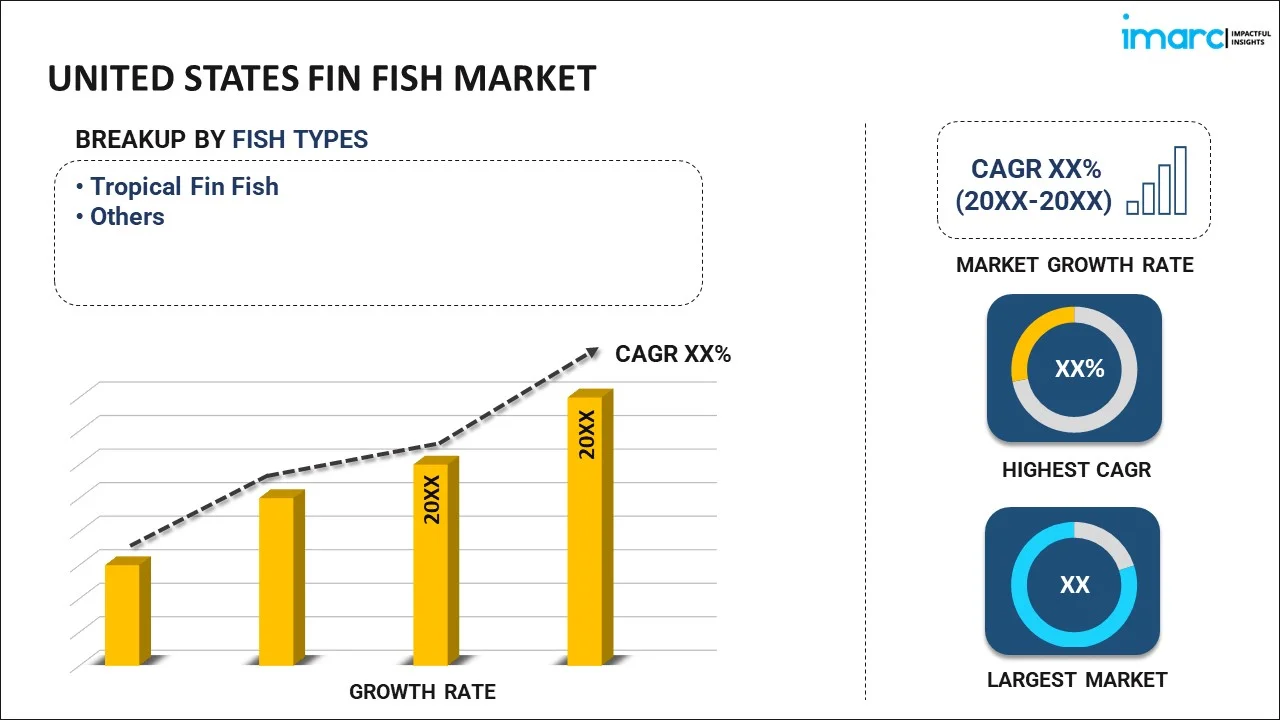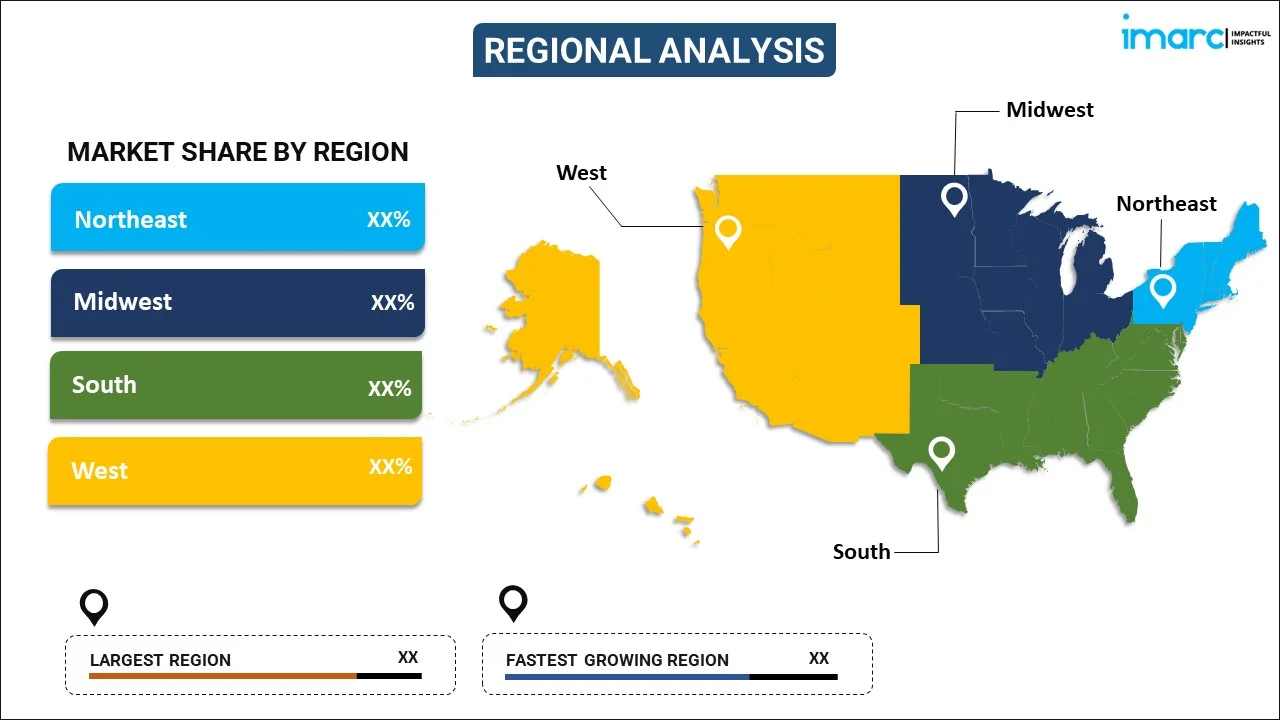
United States Fin Fish Market Report by Fish Type (Tropical Fin Fish, and Others), Environment (Freshwater, Marine Water, Brackish Water), Distribution Channel (Supermarkets and Hypermarkets, Convenience Stores, Specialty Stores, Online Stores, and Others), and Region 2025-2033
Market Overview:
The United States fin fish market size reached USD 49.5 Billion in 2024. Looking forward, IMARC Group expects the market to reach USD 65.9 Billion by 2033, exhibiting a growth rate (CAGR) of 3.05% during 2025-2033. The rising food and beverage (F&B) industry, the increasing consumer demand for seafood as a healthy and protein-rich dietary choice, innovations in aquaculture practices, the rising awareness of health and wellness, and the growth of aquaculture represent some of the key factors driving the market.
|
Report Attribute
|
Key Statistics
|
|---|---|
|
Base Year
|
2024 |
|
Forecast Years
|
2025-2033 |
|
Historical Years
|
2019-2024
|
| Market Size in 2024 | USD 49.5 Billion |
| Market Forecast in 2033 | USD 65.9 Billion |
| Market Growth Rate (2025-2033) | 3.05% |
Fin fish, also known simply as "fish," refers to a diverse group of aquatic vertebrates characterized by the presence of fins and gills. These animals inhabit freshwater and marine environments, contributing significantly to global fisheries and culinary traditions. Fin fish encompass a vast array of species, each with unique anatomical, behavioral, and ecological characteristics. Fin fish possess streamlined bodies that are adapted for swimming through the water with efficiency. Their fins serve various purposes, including stabilization, propulsion, and steering. Gills, specialized respiratory structures, enable these creatures to extract oxygen from water, facilitating their survival beneath the water's surface. The significance of fin fish extends beyond their biological features. They are a primary source of protein for human consumption, contributing to global food security and nutrition. Many cultures around the world have developed distinct culinary traditions centered around the preparation and consumption of fin fish. Additionally, the fishing industry, which includes both wild capture and aquaculture, plays a crucial economic role by providing employment and contributing to trade.
United States Fin Fish Market Trends:
Significant technological advancements represent one of the key factors driving the growth of the market across the United States. From efficient fishing techniques to improved packaging and transportation methods, technology has streamlined supply chains and enhanced product quality. In addition to this, innovations in aquaculture practices, such as recirculating systems and biosecurity measures, are contributing to the market's growth by increasing production efficiency and reducing environmental impacts. The growth of aquaculture, or fish farming, is playing a pivotal role in meeting consumer demand while addressing concerns about overfishing and environmental impact. This is acting as a major growth-inducing factor. Sustainable sourcing practices, including responsible farming methods and certification programs, are gaining prominence. Consumers are increasingly drawn to fin fish products that are produced in environmentally responsible ways, driving the market toward sustainable and ethical practices. In line with this, the rising awareness of health and wellness, coupled with increased access to information, is prompting consumers to prioritize their dietary choices more conscientiously. As research continues to highlight the health benefits of consuming fin fish, including potential cardiovascular and cognitive advantages, individuals are incorporating fish into their diets as a means of promoting overall well-being. The market is also driven by the increasing consumer demand for seafood as a healthy and protein-rich dietary choice. Fish is widely acknowledged for its nutritional benefits, including being a source of omega-3 fatty acids, lean protein, and various vitamins and minerals. As health-conscious eating habits continue to gain momentum, consumers are seeking alternatives to traditional meat sources, elevating the demand for fin fish. The multicultural nature of the United States is leading to an increasing appreciation for diverse culinary experiences. Fin fish, with its various species and preparation methods, offers a wide range of flavors and textures. As consumers become more adventurous with their food choices, the demand for different types of fin fish increases, which is fostering opportunities for both domestic and international producers. The globalization of supply chains is enabling consumers to access a wide variety of fin fish species from around the world. This trade dynamic not only expands consumer choice but also influences market prices and availability based on global supply and demand, which is further creating a positive outlook for the market across the country.
United States Fin Fish Market Segmentation:
IMARC Group provides an analysis of the key trends in each segment of the United States fin fish market report, along with forecasts at the country level for 2025-2033. Our report has categorized the market based on fish type, environment, and distribution channel.
Fish Type Insights:

- Tropical Fin Fish
- Pompano
- Snappers
- Groupers
- Salmon
- Milkfish
- Tuna
- Tilapia
- Catfish
- Seabass
- Others
- Others
The report has provided a detailed breakup and analysis of the market based on the fish type. This includes tropical fin fish (pompano, snappers, groupers, salmon, milkfish, tuna, tilapia, catfish, seabass, and others) and others.
Environment Insights:
- Freshwater
- Marine Water
- Brackish Water
A detailed breakup and analysis of the market based on the environment has also been provided in the report. This includes freshwater, marine water, and brackish water.
Distribution Channel Insights:
- Supermarkets and Hypermarkets
- Convenience Stores
- Specialty Stores
- Online Stores
- Others
A detailed breakup and analysis of the market based on the distribution channel has also been provided in the report. This includes supermarkets and hypermarkets, convenience stores, specialty stores, online stores, and others.
Regional Insights:

- Northeast
- Midwest
- South
- West
The report has also provided a comprehensive analysis of all the major regional markets, which include the Northeast, Midwest, South, and West.
Competitive Landscape:
The report has also provided a comprehensive analysis of the competitive landscape in the United States fin fish market. Competitive analysis such as market structure, key player positioning, top winning strategies, competitive dashboard, and company evaluation quadrant has been covered in the report. Also, detailed profiles of all major companies have been provided.
United States Fin Fish Market Report Scope:
| Report Features | Details |
|---|---|
| Base Year of the Analysis | 2024 |
| Historical Period | 2019-2024 |
| Forecast Period | 2025-2033 |
| Units | Billion USD |
| Scope of the Report | Exploration of Historical and Forecast Trends, Industry Catalysts and Challenges, Segment-Wise Historical and Predictive Market Assessment:
|
| Fish Types Covered |
|
| Environments Covered | Freshwater, Marine Water, Brackish Water |
| Distribution Channels Covered | Supermarkets and Hypermarkets, Convenience Stores, Specialty Stores, Online Stores, Others |
| Regions Covered | Northeast, Midwest, South, West |
| Customization Scope | 10% Free Customization |
| Post-Sale Analyst Support | 10-12 Weeks |
| Delivery Format | PDF and Excel through Email (We can also provide the editable version of the report in PPT/Word format on special request) |
Key Questions Answered in This Report:
- How has the United States fin fish market performed so far and how will it perform in the coming years?
- What has been the impact of COVID-19 on the United States fin fish market?
- What is the breakup of the United States fin fish market on the basis of fish type?
- What is the breakup of the United States fin fish market on the basis of the environment?
- What is the breakup of the United States fin fish market on the basis of distribution channel?
- What are the various stages in the value chain of the United States fin fish market?
- What are the key driving factors and challenges in the United States fin fish market?
- What is the structure of the United States fin fish market and who are the key players?
- What is the degree of competition in the United States fin fish market?
Key Benefits for Stakeholders:
- IMARC’s report offers a comprehensive quantitative analysis of various market segments, historical and current market trends, market forecasts, and dynamics of the United States fin fish market from 2019-2033.
- The research study provides the latest information on the market drivers, challenges, and opportunities in the United States fin fish market.
- Porter's five forces analysis assist stakeholders in assessing the impact of new entrants, competitive rivalry, supplier power, buyer power, and the threat of substitution. It helps stakeholders to analyze the level of competition within the United States fin fish industry and its attractiveness.
- Competitive landscape allows stakeholders to understand their competitive environment and provides an insight into the current positions of key players in the market.
Need more help?
- Speak to our experienced analysts for insights on the current market scenarios.
- Include additional segments and countries to customize the report as per your requirement.
- Gain an unparalleled competitive advantage in your domain by understanding how to utilize the report and positively impacting your operations and revenue.
- For further assistance, please connect with our analysts.
 Inquire Before Buying
Inquire Before Buying
 Speak to an Analyst
Speak to an Analyst
 Request Brochure
Request Brochure
 Request Customization
Request Customization




.webp)




.webp)












